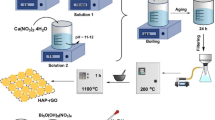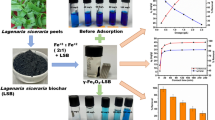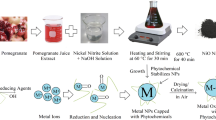Abstract
The development of shirasu balloons (SB) modified with polydopamine (PDA) has been conducted. The aim of this research is to increase the performance of shirasu balloons in the adsorption of methylene blue (MB). The SB modified with PDA (SB/PDA) was prepared by immersing SB in the dopamine solution in the aerobic alkaline condition. The prepared material was characterized using Fourier transform infrared spectroscopy (FTIR), scanning electron microscopy with energy dispersive X-ray spectrometry (SEM-EDS), specific surface area N2 sorption, and zeta potential analysis. The adsorption behavior of SB and SB/PDA was investigated by studying the effect of the pH, adsorption kinetics, and effect of salt concentration. The adsorption kinetics of SB before and after modification was analyzed using two kinetics models, i.e., pseudo-first order and pseudo-second order. The adsorption isotherm was analyzed using Langmuir and Freundlich models. The adsorption study results showed that the adsorption isotherm fitted to Langmuir isotherm with a maximum capacity that could reach up to 26.17 mg g−1 for SB and 36.23 mg g−1 for SB/PDA. The adsorption kinetics showed that adsorption behavior followed the pseudo-second-order kinetic model and the equilibrium time for each material can be obtained at 5 min shaking time.








Similar content being viewed by others
References
Anderson, T. H., Yu, J., Estrada, A., Hammer, M. U., Waite, J. H., & Israelachvili, J. N. (2010). The contribution of DOPA to substrate-peptide adhesion and internal cohesion of mussel-inspired synthetic peptide films. Advanced Functional Materials, 20(23), 4196–4205.
Ball, V. (2010). Impedance spectroscopy and zeta potential titration of dopa-melanin films produced by oxidation of dopamine. Colloids and Surfaces A: Physicochemical and Engineering Aspects, 363, 92–97.
Buthelezy, S. P., Olaniran, A. O., & Pillay, B. (2012). Textile dye removal from wastewater effluents using bioflocculants produced by indigenous bacterial isolates. Molecules, 17, 14260–14274.
Cheng, C., Li, S., Zhao, W., Wei, Q., Nie, S., Sun, S., & Zhao, C. (2012). The hydrodynamic permeability and surface property of polyethersulfone ultrafiltration membranes with mussel-inspired polydopamine modification. Journal of Membrane Science, 417–418, 228–236.
Cui, J., Sun, H., Luo, Z., Sun, J., & Wen, Z. (2015). Preparation of low surface area SiO2 microsphere from wheat hust ask with a facile prepicitation process. Mater Letters. doi:10.1016/j.matlet.2015.04.134.
Dong, Z., Zhang, F., Wang, D., Liu, X., & Jin, J. (2015). Polydopamine-Mediated surface-functionalization of graphene oxide for heavy metal ions removal. Journal of Solid State Chemistry, 224, 88–93.
Fu, J., Chen, Z., Wang, M., Liu, S., Zhang, J., Zhang, J., Han, R., & Xu, Q. (2015). Adsorption of methylene blue by a high-efficiency adsorbent (polydopamine microspheres): Kinetics, isotherm, thermodynamics and mechanism analysis. Chemical Engineering Journal, 259, 53–61.
Han, R., Zhang, J., Han, P., Wang, Y., Zhao, Z., & Tang, M. (2009). Study of equilibrium, kinetic and thermodynamic parameters about methylene blue adsorption onto natural zeolite. Chemical Engineering Journal, 145(3), 496–504.
Hong, G., Shen, L., Wang, M., Yang, Y., Wang, X., Zhu, M., & Hsiao, B. S. (2014). Nanofibrous polydopamine complex membranes for adsorption of lanthanum (III) ions. Chemical Engineering Journal, 244, 307–316.
Jun, D. R., Moon, S. K., & Choi, S. W. (2014). Uniform polydimethylsiloxane beads coated with polydopamine and their potential biomedical applications. Colloids and Surfaces B: Biointerfaces, 121, 395–399.
Kadirvelu, K., Kavipriya, M., & Karthika, C. (2003). Utilization of various agricultural wastes for activated carbon preparation application for the removal of dyes and metal ions from aqueous solutions. Bioresource Technology, 8(1), 129–132.
Li, C., Zhong, H., Wang, S., Xue, J., & Zhang, Z. (2014). Removal of basic dye (methylene blue) from aqueous solution using zeolite synthesized from electrolytic manganese residue. Journal of Industrial and Engineering Chemistry. doi:10.1016/j.jiec.2014.08.038.
Lin, J., & Zhan, Y. (2012). Adsorption of humic acid from aqueous solution onto unmodified and surfactant-modified chitosan/zeolite composites. Journal of Chemical Engineering, 200–202, 202–213.
Liu, Y., Ai, K., & Lu, L. (2014). Polydopamine and its derivative materials: synthesis and promising applications in energy, environmental, and biomedical fields. Chemical Reviews, 114, 5057–5115.
Liu, Y., Li, J., Yang, Y., & Li, B. (2015). Facile immobilization of polyaspartate onto silica gels via poly(dopamine) for the removal of methylene blue from aqueous solution. Applied Surface Science. doi:10.1016/j.apsusc.2015.06.007.
Odzemir, S., Cirik, K., Akman, D., Sahinkaga, E., & Cinar, O. (2013). Treatment of azo dye-containing synthetic textile dye effluent using sulfidogenic anaerobic baffled reactor. Bioresource Technology, 146, 135–143.
Ollikka, P., Alhonmaki, K., Leppanen, V. M., Glumoff, T., Raijola, T., & Suominen, I. (1993). Decolorization of azo, tripenylmethane, heterocyclic, and polymeric dyes by lignin peroxidase isoenzymes from phanerochaete chrysosporium. Applied and Environmental Microbiology, 59, 4010–4016.
Pajootan, E., Arami, M., & Mahmoodi, N. M. (2012). Binary system dye removal by electrocoagulation from synthetic and real colored wastewaters. Journal of the Taiwan Institute of Chemical Engineers, 43, 282–290.
Quintelas, C., Rocha, Z., Silva, B., Fonseca, B., Figueiredo, H., & Tavares, T. (2009). Removal of Cd(II), Cr(II), Fe(II) and Ni(II) from aqueous solutions by an E. coli biofilm supported on kaolin. Journal of Chemical Engineering, 149(1–3), 319–324.
Rida, K., Bouraoui, S., & Hadnine, S., (2013). Adsorption of methylene blue from aqueous solution by kaolin and zeolite. Applied Clay Sciece, 83, 99–105.
Saratale, G. D., Saratale, R. G., Chang, J. S., & Govindwar, S. P. (2011). Bacterial decolorization and degradation of azo dyes: A review. International Biodeterioration and Biodegradation, 65, 494–503.
Simon, J. D., & Peles, D. N. (2010). The red and the black. Accounts of Chemical Research, 43, 1452–1460.
Sohrabnezhad, S., & Pourahmad, A. (2010). Comparison absorption of new methylene blue dye in zeolite and nanocrystal zeolite. Desalination, 256, 84–89.
Taha, A. A., Qiao, J., Li, F., & Zhang, B. (2011). Preparation and application of amino functionalized mesoporous nanofiber membrane via electrospinning for adsorption of Cr3+ from aqueous solution. Journal of Environmental Sciences, 24, 610–616.
Wong, Y. C., Szeto, Y. S., Cheung, W. H., & McKay, G. (2004). Adsorption of acid dyes on chitosan—equilibrium isotherm analyses. Process Biochemistry, 39(6), 695–704.
Yagub, M. T., Sen, T. K., Afroze, S., & Ang, H. M. (2014). Dye and its removal from aqueous solution by adsorption: A review. Advances in Colloid and Interface Science, 209, 172–184.
Yan, J., Huang, Y., Miao, Y., Tjiu, W. W., & Liu, T. (2015). Polydopamine-coated electrospun poly(vinyl alcohol)/poly(acrylic acid) membranes as efficient dye adsorbent with good recyclability. Journal of Hazardous Materials, 283, 730–739.
Yu, Y., Shapter, J. G., Popelka-Filcoff, R., & Bennett, J. W. (2014). Copper removal using bio-inspired polydopamine coated natural zeolites. Journal of Hazardous Materials, 273, 174–182.
Acknowledgments
This work was supported by the Graduate School of Environmental Science, Hokkaido University; Department of Chemistry, Universitas Gadjah Mada (UGM), Yogyakarta; Population-Activities-Resources-Environment (PARE) program; and Laboratorium Penelitian dan Pengujian Terpadu (LPPT), UGM.
Author information
Authors and Affiliations
Corresponding author
Rights and permissions
About this article
Cite this article
Chairunnisa, Siswanta, D., Suratman, A. et al. Shirasu Balloons and Polydopamine-Modified Shirasu Balloons for Adsorption of Methylene Blue. Water Air Soil Pollut 227, 412 (2016). https://doi.org/10.1007/s11270-016-2898-8
Received:
Accepted:
Published:
DOI: https://doi.org/10.1007/s11270-016-2898-8




